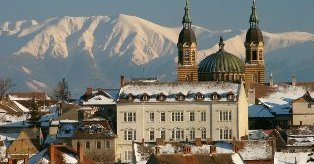The town is going to share this privilege with Luxembourg, with which it has strong historical relations.
In fact, the founders of Sibiu, the Saxons, come from the today Grand Duchy; this explains the almost organic bound between the Romanian town and the capital of Luxembourg.
It is not a surprise that this city, situated in the west of Romania, became the European cultural capital just the year Romania joined the European Union.
Sibiu has, actually, a European destiny because of its geographical position, the mingling of two cultures and because of its population’s ethnic composition.
A real melting pot city, a European destiny

Sibiu is first of all a melting pot of Romanians, Germans, Hungarians and Rhom citizens. Thus, the town is an important example of unity and success under the sign of diversity. It was built on the ruins of Roman settings in the 13th century by German colonists, coming from the Rhine-Moselle region; it developed economically and politically in the Middle Age.
A crossing point town, in the 17th century it becomes the capital of Austro-Hungarian Transylvania and political centre of Germans from the province.
Sibiu is also an enduring town of great battles in the name of justice. It had different causes for every century: in the 19th century, the Romanian national issue sustained by the intellectuals of the town; in the 20th century, the revolution against the communist rule, which mobilized all its citizens in December, 1989.
Sibiu is, finally, an important Romanian cultural place. In addition to its museums, its theatres, numerous festivals, the town reveals a unique architecture in Romania as well as in East Europe. We find here all the styles, from baroque to gothic and modern art.
Sibiu, an important cultural place

There are two different entities, two different environments coexisting in Sibiu: we make reference here to the “upper town” and the “lower town”. The “upper town”, the real heart of Sibiu, includes the three most important squares, each one displaying its own style, its one charm.
Square Huet, initial centre of the town, shelters the Evangelical Church, built between 1371 and 1520 in gothic style. The church gives the square the role of a "religious place".
The Little Square, having the shape of a crescent, is dominated by the Universal Ethnographical Museum and by the Luxembourg House, symbol made of stone between the two European capitals of 2007.
The Great Square, the centre of the town from the 16th century, reminds us of the baroque style. We can find here the Bruckental Museum, one of the most important Romanian baroque monuments and the Catholic Church, former residence of the Jesuits. The Council Tower, built in the 16th century unifies The Little Square with the Great Square.
The architecture of the “lower town” numbers only two-storey houses built in a Saxon style, big roofs and doors revealing beautiful interior courtyards. This part of Sibiu is less majestic but it still has the fingerprints of the Saxon heritage.
“Cultural City – City of Cultures” (the slogan of “Sibiu 2007”)

Sibiu is also a city of cultures, as proved by the mixture of Saxon architectural rigor and the Romanian creativity. The Astra Popular Civilization Museum from Dumbrava presents handicraft objects from all over Romania. Through the popular art, the creative, simple and refined Romanian civilization reveals to greenhorns.
For the year 2007 Sibiu, “the European cultural capital”, has several objectives; among them, there is the increase of the international fame, the long term tourism development, and the promotion of the culture, social cohesion as well as the European cooperation.
So as to accomplish these goals, there has been set up a very rich cultural programme gathering various domains such as: literature, art, music, conferences, debates, thematic expositions. The expositions on the European traits of the town and its inhabitants, the manifestations presenting the Saxon patrimonies and those presenting the creativity of the Romanian folklore are but a few examples of the multiple choice of the programme “Sibiu 2007”.
Sibiu has also scheduled a common programme with Luxembourg in order to have a real cultural axe “East-West”. “A European marathon of poetry” will be organized during three days in particular places from Sibiu and Luxembourg; there are also going to take place philharmonic concerts in both cities, as well as the showing of historical films of the two “European cultural capitals”.
The programme “Sibiu 2007” is very well organized taking into consideration the history of this city being a true melting pot.


Follow the comments: |
|
